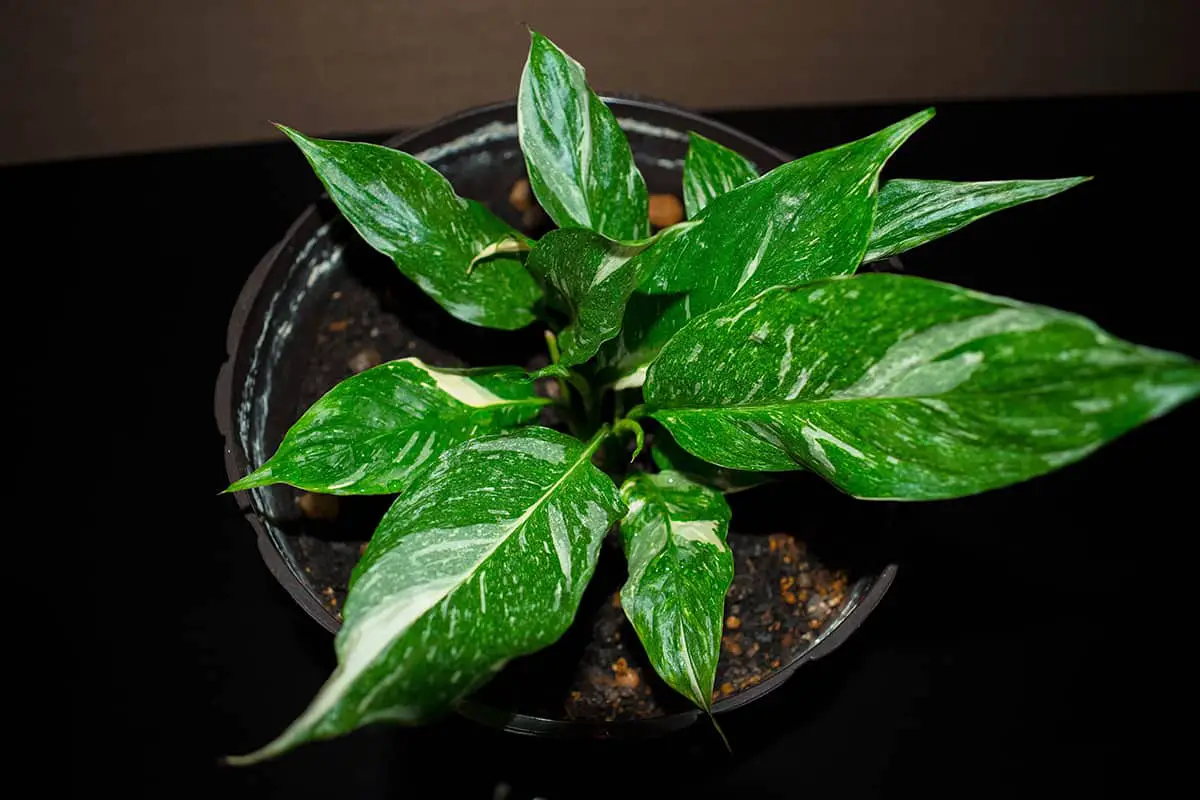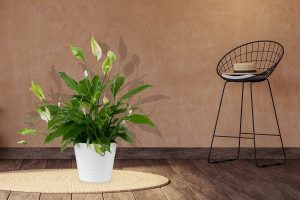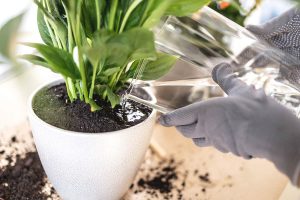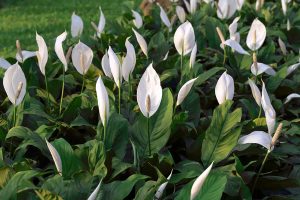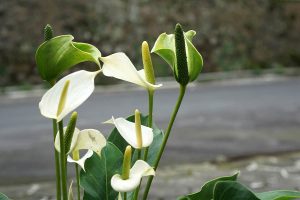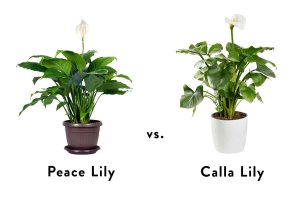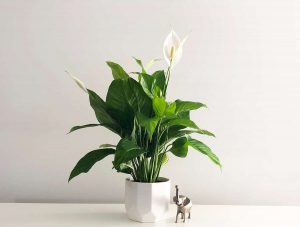The Spathiphyllum Domino plant is a variety of Peace Lily. It features delicate variegation on the foliage, which makes it more appealing than standard Peace Lilies. Here we take a closer look at the Domino Peace Lily and explain how to ensure the plant thrives in your care.
| Botanical name | Spathiphyllum ‘Domino’ |
| Common names | Domino Peace Lily, Variegated Peace Lily |
| Plant family | Araceae |
| USDA hardiness zone | 10 and 11 |
| Mature height | Up to 4 feet |
| Mature spread | Up to 4 feet |
Table of Contents
Varieties of Spathiphyllum Domino
Picasso Peace Lily
This variety of Spathiphyllum is named after the famous painter Pablo Picasso. Like the Domino Peace Lily, it features variegated leaves but in a much more random and bold pattern. The foliage is predominantly dark green, with heavy splashes of cream and pale green.
Piccolino Peace Lily
This is a dwarf variety of Peace Lily that will not exceed 12 inches in height and typically will top out at heights of between 8 and 10 inches. It is considerably smaller than the Domino Peace Lily but has the same care requirements.
How to Care for a Spathiphyllum Domino
The Spathiphyllum Domino, more commonly known as the Domino Peace Lily, is a fairly forgiving plant in many areas of its care, and as such, it is commonly recommended for beginner house plant owners because it won’t be easily killed off.
Despite its elegant and almost dainty look, this plant is quite a tough cookie. If you want to get the most out of your Domino Peace Lily, follow the care guidelines below.
Light
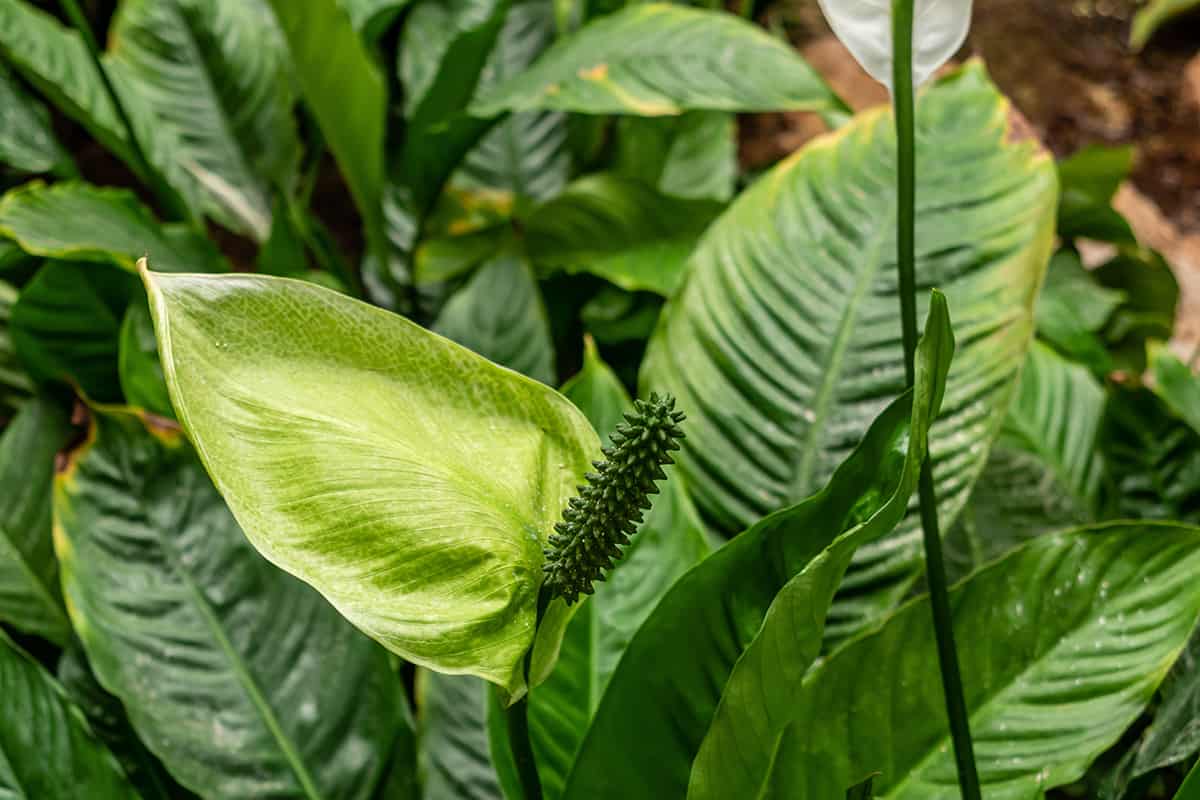
Peace Lilies are well known for the fact that they are able to adapt to varying levels of light. They are often kept in darker corners of a home because they will tolerate low light better than most other types of houseplants. However, they can also thrive in bright light, so don’t be shy about putting your Peace Lily in a more prominent, well-lit position.
Like other Peace Lilies, the Domino Peace Lily will fare well in low light or bright light; however, be careful not to subject the plant to full shade. Low light means dappled light or a conservative few hours of light outside of the brightest hours of the day. It does not mean total darkness, which the Domino Peace Lily will not survive in.
You should also avoid putting this plant in a south-facing window because it will not appreciate direct bright light. Instead, position it in indirect bright light, for example, a few feet away from a window or behind sheer drapes to filter the light.
Since the Domino Peace Lily is a variegated variety of Peace Lily, you may find that it performs better in bright indirect light than low or medium light. This is because it is only the green parts of the leaves that contain chlorophyll, which is needed to perform photosynthesis.
This means variegated plants with significant portions of leaves that are not green will have to work harder to photosynthesize, and therefore they need all the help they can get. A higher level of light will go a long way to helping the Domino Peace Lily do this, which will result in a healthier plant.
The level of light you allow your Domino Peace Lily to get will also affect its ability to bloom. When kept in brighter levels of light, you can expect your Peace Lily to bloom more heavily and more frequently compared with those kept in lower light conditions.
Water
The Domino Peace Lily loves to be grown in moist, but not wet, soil. It is quite fussy when it comes to this element of its care, and its foliage will wilt dramatically when the soil begins to dry out.
A wilted Domino Peace Lily can be revived by giving it a generous soak, but you should aim to water the plant before the leaves wilt, because continual wilting will take considerable energy, and after multiple episodes you may find that the leaves struggle to fully recover.
Instead, ensure the soil of your Domino Peace Lily is kept moist at all times. You can do this by visually checking the condition of the soil every few days. When the top layer of soil appears to be dried out, add more water to the plant. You can also dip a finger into the soil to check for moisture if you want a more accurate picture of the soil’s condition.
Although the Domino Peace Lily is a thirsty plant, it will not tolerate sitting in standing water. For this reason, it is vital that your plant pot has drainage holes and that any excess water is able to drain away from the roots. Too much water will lead to root rot, which is a death sentence for many house plants.
House plants, in general, will perform best when they are watered according to the condition of their soil, rather than according to a schedule. This is because the frequency of watering will depend upon various factors, such as how big the plant is, how much light it receives, and the typical temperature in the room.
However, if you are looking for guidelines for the typical frequency of watering a Domino Peace Lily requires, you should expect to water this plant around twice a week throughout its growing period in spring and summer and withdraw to watering the plant once a week for the remaining seasons.
In terms of the type of water you use to irrigate your Domino Peace Lily, it is useful to know that most types of Peace Lily are sensitive to chlorine in the water. If your tap water is known to have high levels of chlorine present, then you might want to alter the way you water this plant.
You could use a water butt in the garden to collect natural rainwater and use this water on your Peace Lily, or alternatively, simply set a watering can outside and collect rainwater in this way. If you live in a climate with low rainfall, you can use tap water to irrigate your plants, but instead of using the water straight from the tap, pour it into a bowl and let it sit for a day or two before you add it to the soil of your plants.
This allows the chlorine to dissipate. You could also consider using filtered water, but considering how thirsty the Domino Peace Lily is, this could prove to be quite expensive.
Temperature
The Domino Peace Lily grows best when it is kept in the temperature range of 65 to 75°F. It is native to tropical regions of South America and Asia, and as such, it is accustomed to growing in hot climates. It can be grown outdoors all year round in regions that imitate the plant’s natural environment, namely USDA hardiness zones 10 and 11, where the temperature does not drop too low at any point in the year.
Since the Domino Peace Lily is not hardy, it is ideal for use as a houseplant. Typical room temperatures sit within the ideal range of 65 to 75°F, making indoor homes and offices the perfect place to keep this plant.
Humidity
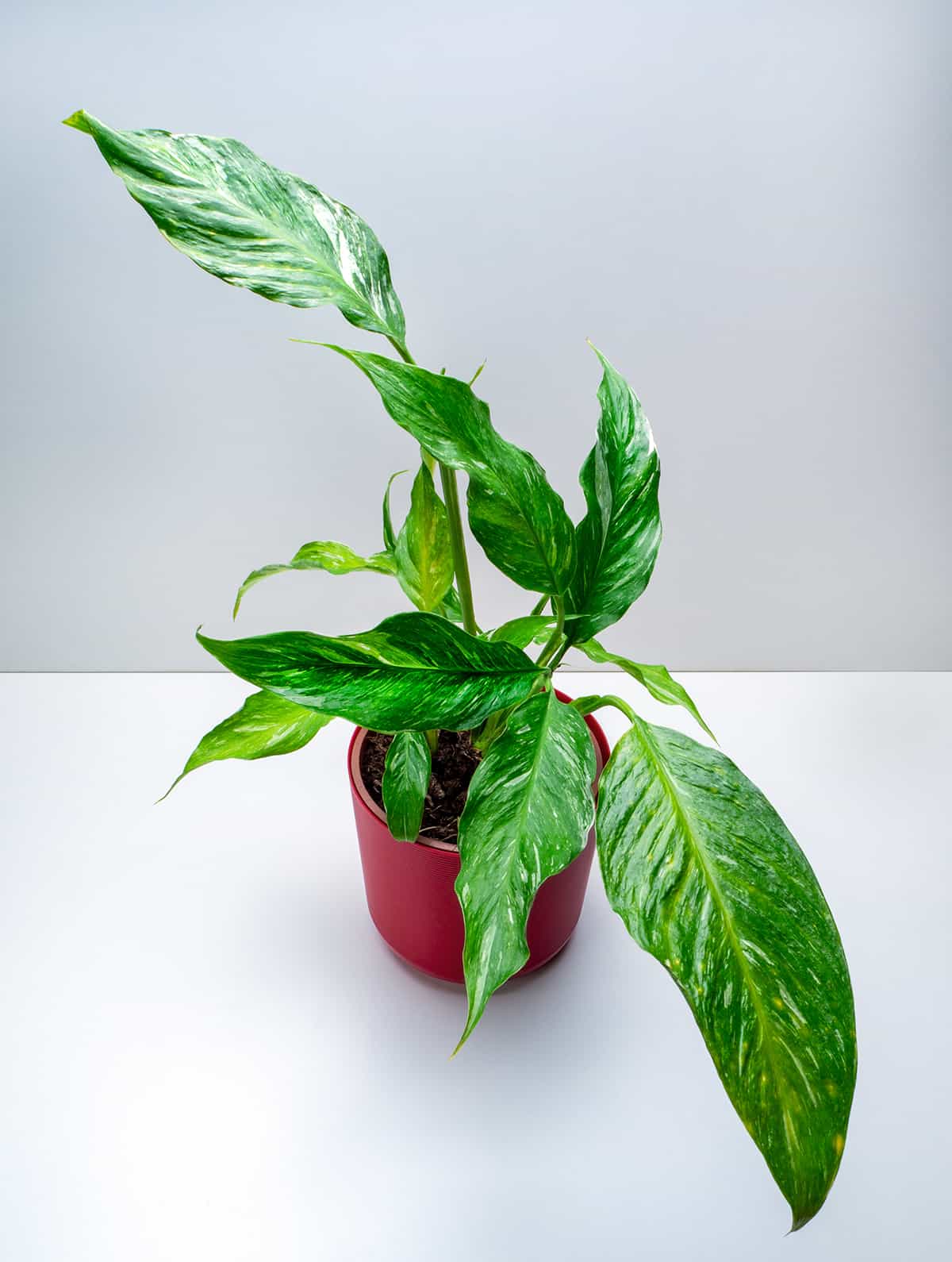
As a native plant of tropical regions, the Domino Peace Lily is used to living with high humidity. It will thrive in humid conditions, for example, in a bathroom, but it will also fare just fine in the air that does not have a high moisture content. If you want a plant that isn’t very demanding in terms of humidity, then the Domino Peace Lily is a good option because you won’t need to make alterations to the humidity in your home.
However, if you like to tend to your houseplants, spritz the leaves of the Domino Peace Lily every few days with a water mist to keep them super happy. You could also arrange the Domino Peace Lily amongst a group of other houseplants because when plants are grouped together, they benefit from the rise in humidity this causes.
Fertilizer
The Domino Peace Lily can be strong and healthy without the addition of fertilizer, but if you want to see prolific blooming on this plant, then it is a good idea to use plant food throughout spring and summer. Use a diluted fertilizer every two weeks through the growing season to encourage flowering.
Spathiphyllum Domino FAQs
Can Spathiphyllum Dominos live outside?
The Domino Peace Lily is not frost hardy, so it cannot live outside in regions where frost is likely. Keep it as a houseplant unless you live in USDA hardiness zones 10 or 11, where it can be grown outside all year round.
Are Spathiphyllum Dominos good for you?
The Domino Peace Lily is known to be excellent at filtering dangerous toxins from the air, such as formaldehyde, so it is a great plant to have in the home or office because it will clean the air you breathe.
